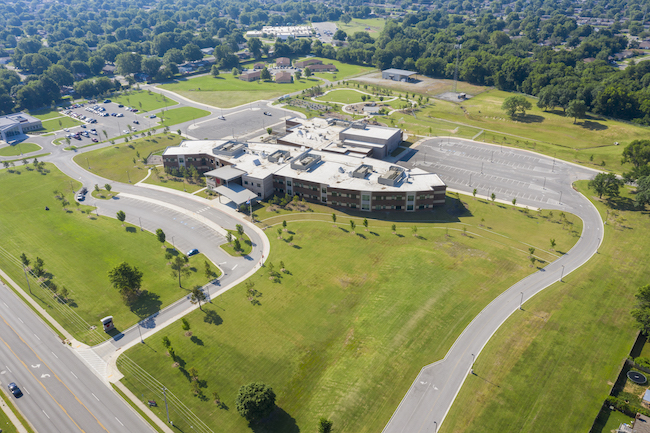Welcome back to Summer School: Facilities Maintenance Edition!
School’s out, which means it’s a great time for school districts to take a hard look at their facilities and make sure they can pass the tests of the upcoming school year. We understand that facilities maintenance isn’t typically the first thing on a school district’s mind, especially when it comes to budgeting. So we’re here to provide some quick summer school primers on the importance of directing attention to assets that are often taken for granted – and why hiring a consultant to manage these overlooked components can reduce stress and save money.
A few weeks ago in Part I of our series, we gave a mini tutorial on why your school district needs a roof consultant, discussing how a third party roofing expert can help you budget wisely, stay ahead of leaks, and keep track of all of your roof repairs and replacements. This week, we’re moving from the roof down to the ground to talk about pavement management.
Think about how much traffic a school district’s various campuses see on a weekly basis during the school year: hundreds of cars and busses streaming through the drop off and pick up lines, teachers and high school students cramming the parking lots during the day, parents coming in for sports and PTA in the evenings, and even more traffic for extracurriculars on the weekends. Combine that wear and tear with a little oil, coolant, and brake fluid plus cycles of hot sun, pounding rain, and harsh snow and ice, and it’s a sure recipe for deterioration.
A little maintenance can go a long way in keeping asphalt and concrete pavement functional. But with acres of parking lots and driveways and only a sliver of budget, where do you start? A pavement management program can help you figure it out.
To get the lowdown on pavement management, we caught up with Alan Taylor, PE, a civil engineering Principal at Wallace Design Collective. In Part II of our series, he’s breaking down what a pavement management program is and why school districts should consider hiring a consultant to help them manage their pavement before deterioration gets out of hand.
What is a pavement management program?
Pavement management programs help organizations with large complexes or multiple sites quantify their total pavement extents, understand the condition of every drive lane and parking lot, and set up a repair plan. According to Taylor, his team first catalogs all parking lots and drives and then walks the sites to perform a baseline assessment of each area. Then, they rank the different areas in terms of deterioration severity and help the client build a maintenance schedule that hones in on areas that need to be repaired first.
“Some of it may need routine maintenance, some of it may need full replacement, and we can help them prioritize those things and come up with costs,” explains Taylor.
Taylor also notes that a pavement management program can help a client put a total value on their pavement assets.
“People put a value on a building, but they don’t really think of pavement as having a value, but it really does because it’s got such a high cost to replace.”
Isn’t it obvious when pavement needs to be repaired? Why bother hiring a consultant?
“I think everyone can look at pavement and see cracks, but especially as you look at a bigger scale, I think the value we bring is identifying what pavements need more immediate attention and what pavements don’t,” says Taylor.
Taylor goes on to note that there are a lot of different types of cracking and underlying causes. While some types raise a red flag because they will continue to become more severe, other types may have a low likelihood of becoming worse and don’t need to be addressed right away.
Also, certain signs of damage or future problems may not be obvious to the untrained eye. For example, depressions where wheels typically rest in parking spaces may seem innocent, especially if not accompanied by cracks. However, according to Taylor, these depressions are an indication of base failure, or poor compaction of the subgrade below the pavement that occurred during construction. If it’s widespread, you could start seeing other issues throughout the lot.
What are the physical consequences of ignoring pavement maintenance?
Ignoring pavement maintenance will eventually lead to safety hazards – and by that time, the cost of emergency large scale repairs or replacement could be staggering.
“At some point, you develop such significant cracks, potholes, or degradation of the pavement, that it could be creating tripping hazards, or it could be that you’re holding water where you shouldn’t be and it becomes slip hazards in winter,” says Taylor. “It takes a long time to get to that condition, but if you do nothing, any pavement will get there. All pavement requires some maintenance, and the longer you wait, the more it costs to fix.”
What are the financial consequences of ignoring pavement maintenance?
Of course, final costs are always site specific and depend on a range of variables, but according to Taylor, the average parking lot replacement lands somewhere in the range of $10 per square foot. On the other hand, regular maintenance like sealing cracks or joints to keep water out of the subgrade rings up at a few dollars per linear foot, or usually less than $1 per square foot.
“That’s a huge difference in cost, to reseal some joints and do a few patches every few years versus waiting until you’ve got a significant problem.”
Overall, why should a school district invest in a pavement management program?
Pavement is one of those unglamorous infrastructure elements that takes a lot of abuse, but nobody pays much attention until it causes problems. Periodic strategic maintenance can help ensure a long life, but monitoring and repairing pavement across multiple sites is a big job, one that could easily get lost in the shuffle of the many other duties handled by a school district’s facilities maintenance team.
Having a dedicated pavement management consultant can help make sure this task gets the attention it needs while also ensuring smart spending. Taylor sums it up best:
“What we come in and do is provide them a holistic view of all of their assets so that they spend their money in the right places when it comes time to do construction. In the long run, they save money on future replacements by being strategic on where they do regular maintenance.”
____________
Interested in learning more about how Wallace Design Collective’s pavement management services can increase pavement life and benefit your budget? Contact us today for more information.


There are no comments.